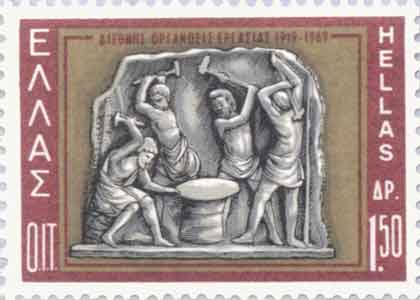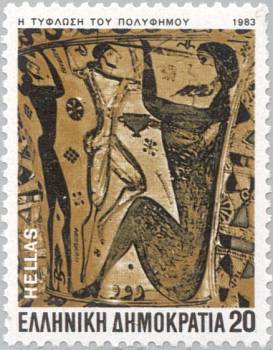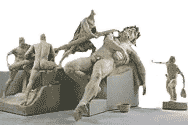.

Armor production by Hephaestus and three Cyclopes
The earliest inhabitants (Sicily) spoken of in any part of the country are the Cyclopes and Laestrygones; but I cannot tell of what race they were, or whence they came or whither they went, and must leave my readers to what the poets have said of them and to what may be generally known concerning them. Thucydides History of the Peloponnesian War, Book VI
In Greek mythology a Cyclops (pronounced Cyclōps), or Kyklops (Greek Κύκλωψ), is a member of a primordial race of giants, each with a single round eye in the middle of its forehead. The plural is Cyclopes (prounounced Cyclōpis) or Kyklopes (Greek Κύκλωπες). The name means "round-" or "wheel-eyed".
Hesiod describes one group of cyclopes and Homer describes another. In Hesiod's Theogony, Zeus releases three Cyclopes, the sons of Uranus and Gaia, from the dark pit of Tartarus. They provide Zeus's thunderbolt, Hades' helmet of invisibility, and Poseidon's trident, and the gods use these weapons to defeat the titans. In a famous passages of Homer's Odyssey, the hero Odysseus encounters the Cyclops Polyphemus, the son of Poseidon and a nereid (Thoosa), who lives with his fellow Cyclopes in a distant country. The connection between the two groups has been debated in antiquity and by modern scholars.[1]
Hesiod's Cyclops
And again, she bare the Cyclopes, overbearing in spirit, Brontes, and Steropes and stubborn-hearted Arges (6), who gave Zeus the thunder and made the thunderbolt: in all else they were like the gods, but one eye only was set in the midst of their fore-heads. And they were surnamed Cyclopes (Orb-eyed) because one orbed eye was set in their foreheads. Strength and might and craft were in their works. Hesiod Theogony
In the Theogony, the Cyclopes—Brontes, Steropes and Arges —were the sons of Uranus (Sky) and Gaia (Earth). Like their brothers, the Hecatonchires ("hundred-handed ones"), they were primordial sons of Sky and Earth. They were giants with a single eye in the middle of their forehead and a foul disposition. According to Hesiod, they were strong, stubborn, and "abrupt of emotion". Collectively they eventually became synonyms for brute strength and power, and their name was invoked in connection with massive masonry and especially well-crafted weapons.
Uranus, fearing their strength, locked them in Tartarus. Cronus, another son of Uranus and Gaia, later freed the Cyclopes, along with the Hecatonchires, after he had overthrown Uranus. But Cronus then placed them back in Tartarus, where they remained, guarded by the she-dragon Campe, until freed by Zeus. They fashioned thunderbolts for Zeus to use as weapons, and helped him overthrow Cronus and the other Titans. The thunderbolts, which became Zeus' main weapons, were forged by all three Cyclopes: Arges added brightness, Brontes added thunder, and Steropes added lightning.
These Cyclopes also created Poseidon's trident, Artemis' bow and arrow, and the helmet of darkness that Hades gave to Perseus on his quest to kill Medusa. According to a hymn of Callimachus,[2] they were Hephaestus' helpers at the forge. The Cyclopes were said to have built the "cyclopean" fortifications at Tiryns and Mycenae in the Peloponnese. The noises proceeding from the heart of volcanoes were attributed to their operations.
It is said that these Cyclopes were later killed by Apollo after Zeus killed his son, Asclepius, with a Cyclopes-forged thunderbolt.
There were three: Brontes, Steropes and Arges. Uranus feared their strength and locked them in Tartarus. Later, Cronus, another son of Uranus and Gaia, freed the Cyclopes, along with the Hecatonchires and Gigantes. They helped him overthrow and castrate Uranus, but Cronus then placed them back in Tartarus, where they remained, guarded by Campe, until freed by Zeus. They fashioned lightning bolts for Zeus to use as a weapon and helped him overthrow Cronus and the other Titans. The thunderbolts which became Zeus' signature weapon were forged by all three Cyclopes: Arges added brightness, Brontes added thunder, and Steropes added lightning.
Homer's Cyclopes
The Cyclopes were huge one-eyed monsters that resided on an island with the same name. Commonly, the term "Cyclops" refers to a particular son of Poseidon and Thoosa named Polyphemus who was a Cyclops. Another member of this group of Cyclopes was Telemus, a seer.
Polyphemus
In Book 9 of Homer's Odyssey, a scouting party led by the Trojan War hero Odysseus lands on the Island of the Cyclopes and ventures upon a large cave. They enter into the cave and proceed to feast on some food they find there. Unknown to them, this cave is the home of Polyphemus who soon comes upon the trespassers and traps them in his cave. He proceeds to eat several crew members, but Odysseus devised a cunning plan for escape.
To make Polyphemus unwary, Odysseus gives him a skin of very strong, unwatered wine. When Polyphemus asks for Odysseus' name, he tells him that it is 'Outis', Greek for 'no man' or 'nobody'. Once the giant falls asleep drunk, Odysseus and his men take the spit from the fire and drive it through Polyphemus' only eye. Polyphemus' cries of help are answered by the others of his race; however, they turn away from aiding him when they hear that "Nobody" is the cause of his woes.
In the morning, Odysseus ties his men and himself to the undersides of Polyphemus' sheep. When the Cyclops lets the sheep out to graze, the men are carried out. Since Polyphemus has been blinded, he doesn't see the men, but feels the tops of his sheep to make sure the men aren't riding them. As he sailed away, Odysseus shouts "Cyclops, when your father asks who took your eye, tell him that it was Odysseus, Sacker of Cities, Destroyer of Troy, son of Laertes, and King of Ithaca," which proves to be a catastrophic example of hubris. Now knowing his attacker's name, Polyphemus asks his father Poseidon to prevent Odysseus from returning home to Ithaca, or to at least deprive him of his ship and crew.
This tale from the Odyssey is more humorously told in the only surviving satyr play, entitled Cyclops by Euripides.
The Sicilian Greek poet Theocritus wrote two poems circa 275 BC concerning Polyphemus' love for Galatea, a sea nymph. When Galatea instead loved Acis, a Sicilian mortal, a jealous Polyphemus killed him with a boulder. Galatea turned Acis' blood into a river of the same name in Sicily.
Within the sanctuary of Poseidon at Isthmia, Pausanias saw a temple of Palaemon,
There is also what is called his Holy of Holies, and an underground descent to it, where they say that Palaemon is concealed. Whosoever, whether Corinthian or stranger, swears falsely here, can by no means escape from his oath. There is also an ancient sanctuary called the altar of the Cyclopes, and they sacrifice to the Cyclopes upon it."
— Pausanias, 2.2.1
Etymology
From Greek cyclos (κύκλος), "circle" + ops, "eye".
Origins
Walter Burkert among others suggests[3]that the archaic groups or societies of lesser gods mirror real cult associations: "it may be surmised that smith guilds lie behind Cabeiri, Idaian Dactyloi, Telchines, and Cyclopes." Given their penchant for blacksmithing, many scholars believe the legend of the Cyclopes' single eye arose from an actual practice of blacksmiths wearing an eyepatch over one eye to prevent flying sparks from blinding them in both eyes. The Cyclopes seen in Homer's Odyssey are of a different type from those in the Theogony; they were most likely much later additions to the pantheon and have no connection to blacksmithing. It is possible that legends associated with Polyphemus did not make him a Cyclops before Homer's Odyssey; Polyphemus may have been some sort of local daemon or monster originally. The Triamantes in Cretan legend have been suggested - they were a rural race of man-eating ogres who had a third eye on the back of their head. Other than the detail of the eyes, they sound very similar to the Cyclopes of Homer.
Another possible origin for the Cyclops legend is that prehistoric dwarf elephant skulls - about twice the size of a human skull were found by the Greeks on Crete and Sicily. Due to the large central nasal cavity (for the trunk) in the skull, it might have been believed that this was a large, single, eye-socket. The smaller, actual, eye-sockets are on the sides and, being very shallow, hardly noticeable as such. Given the paucity of experience that the locals likely had with living elephants, they were unlikely to recognize the skull for what it actually was.[4]

Odysseus and his men blinding the cyclop Polyphemus (detail of a proto-attic amphora, c. 650 BC, museum of Eleusis) . There are other vase painting where Polyphemus is shown with two eyes.
Whilst it is commonly accepted that cyclopes have only one eye, the description of Polyphemus by Homer does not match this. There is a vase showing Odysseus blinding the cyclops with a two-pronged fork: this suggests that it might originally have had two eyes.
Veratrum album, or white hellebore, an herbal medicine described by Hippocrates before 400 B.C.,[5] contains the alkaloids cyclopamine and jervine, which are teratogens capable of causing cyclopia (holoprosencephaly).
"Cyclopean" walls
After the "Dark Age" Hellenes looked with awe at the vast dressed blocks that had been used in Mycenaean masonry, at sites like Mycenae and Tiryns or on Cyprus, and they concluded that only the Cyclopes had the combination of skill and strength to build in such a monumental fashion.
Notes
- ^ As Robert Mondi says: "Why is there such a discrepancy between the nature of the Homeric Cyclopes and the nature of those found in Hesiod's Theogony? Ancient commentators were so exercised by this problem that they supposed there to be more than one type of Cyclops, and we must agree that, on the surface at least, these two groups could hardly have less in common." (R. Mondi, 1983. "The Homeric Cyclopes: Folktale, Tradition, and Theme," Transactions of the American Philological Association 113 (1983), pp. 17-18.)
- ^ To Artemis, 46f. See also Virgil's Georgics 4.173 and Aeneid 8.416ff.
- ^ Greek Religion,III.3.2
- ^ Meet the original Cyclops. Retrieved 18 May 2007.
- ^ 1911 Encyclopedia Brittanica, citing Codronchius (Comm.... de elleb., 1610), Castellus (De helleb. epist., 1622), Horace (Sat. ii. 3.80-83, Ep. ad Pis. 300)..
Greek Religion, Walter Burkert
The Odyssey, Homer , Robert Fagles (Translator), Bernard MacGregor Walke Knox (Introduction)
See also : Greek Mythology. Paintings, Drawings
| Ancient Greece
Science, Technology , Medicine , Warfare, , Biographies , Life , Cities/Places/Maps , Arts , Literature , Philosophy ,Olympics, Mythology , History , Images Medieval Greece / Byzantine Empire Science, Technology, Arts, , Warfare , Literature, Biographies, Icons, History Modern Greece Cities, Islands, Regions, Fauna/Flora ,Biographies , History , Warfare, Science/Technology, Literature, Music , Arts , Film/Actors , Sport , Fashion --- |
Retrieved from "http://en.wikipedia.org"
All text is available under the terms of the GNU Free Documentation License



